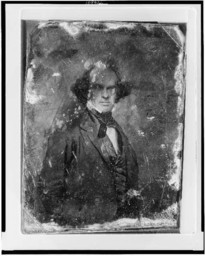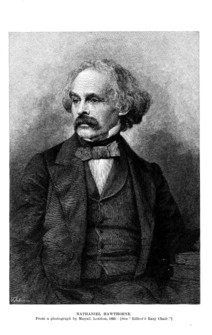|
![[Nathaniel Hawthorne]](../pics/hawthrn3.JPG)


|
Selected
Bibliography: The Blithedale Romance
Discussion
Questions for The Blithedale Romance
Selected
Bibliography: "My Kinsman, Major Molineux"
Hawthorne
crossword puzzle
Cracking the Code of Hawthorne's Allegories (discussion questions)  Nathaniel
Hawthorne Society. This site is essential for learning about the current
state of Hawthorne studies.
Hawthorne in Salem. This
site at North Shore Community College includes biographical and architectural
information as well as pictures of sites associated with Hawthorne, including
the Custom House.
Hawthorne
Home Page. Eric Eldred's excellent Hawthorne site at Eldritch Press
contains all of Hawthorne's works, notes on the writings, annotated editions,and
lots of other information. This is an essential site for those working
on Hawthorne.
The
Scarlet Letter: The Classic Text. This site at the University
of Wisconsin provides background information and critical essays.
Hawthorne in
the Columbia Encyclopedia.This site at bartleby.com has essays by
20th-century critics such as Carl Van Doren.
Hawthorne and Melville. This
page at the Melville site has a great deal of information about the friendship
between these two men.
Biographical
Sketch of Hawthorne from the Heath Anthology site.
Review of a new
biography, Hawthorne in Concord.
Nathaniel Hawthorne
Bicentennial Exhibition at the Phillips Library of the Peabody Essex museum
includes an interactive feature on Hawthorne and his sister's handwritten
1820 newspaper, The Spectator.
 News item (includes picture of Sophia Hawthorne): "Hawthornes to be reunited" News item (includes picture of Sophia Hawthorne): "Hawthornes to be reunited"
Nathaniel Hawthorne
Collection at Bowdoin College.
Portrait of Hawthorne by Charles Osgood (1840) courtesy of the Peabody-EssexMuseum,
Salem, MA
Daguerreotype of Hawthorne circa 1850-55 courtesy of the Library
of Congress.

|
Selected Works
Available Online
Complete
Works of Nathaniel Hawthorne at Eric Eldred's Eldritch Press Hawthorne
site.
The Scarlet
Letter (carefully annotated HTML edition from Eric Eldred)
(1850)
"Hawthorne
and His Mosses" (New York Literary World, August 17 and 24,
1850)
The House
of the Seven Gables (1851) (HTML; Eric Eldred)
The Blithedale
Romance (1852)
The Marble
Faun (1860)
Twice-Told
Tales (1837, 1851)
Mosses
from an Old Manse (1846, 1854) (HTML; Eric Eldred)
The Snow-Image,
and Other Twice-Told Tales (1852)
TheLife
of Franklin Pierce (1852)
"Chiefly
About War Matters" (1862)
The
Whole History of Grandfather's Chair, 1840
A Wonder-Book
for Girls and Boys (1852)
Tanglewood
Tales (1853)
"The
Celestial Railroad"
From Little Masterpieces of American Humor (1903)
IDENTIFIED
Nathaniel Hawthorne was a kind-hearted man as well as a great novelist. While he was consul at Liverpool a young Yankee walked into his office. The boy had left home to seek his fortune, but evidently hadn't found it yet, although he had crossed the sea in his search. Homesick, friendless, nearly penniless, he wanted a passage home. The clerk said Mr. Hawthorne could not be seen, and intimated that the boy was not American, but was trying to steal a passage. The boy stuck to his point, and the clerk at last went to the little room and said to Mr. Hawthorne: "Here's a boy who insists upon seeing you. He says he is an American, but I know he isn't." Hawthorne came out of the room and looked keenly at the eager, ruddy face of the boy. "You want a passage to America?"
"Yes, sir."
"And you say you're an American?"
"Yes, sir."
"From what part of America?"
"United States, sir."
"What State?"
"New Hampshire, sir."
"Town?"
"Exeter, sir."
Hawthorne looked at him for a minute before asking him the next question. "Who sold the best apples in your town?"[Pg 48]
"Skim-milk Folsom, sir," said the boy, with glistening eye, as the old familiar by-word brought up the dear old scenes of home.
"It's all right," said Hawthorne to the clerk; "give him a passage."
|
![]()